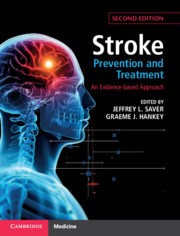Book contents
- Stroke Prevention and Treatment
- Stroke Prevention and Treatment
- Copyright page
- Dedication
- Contents
- Contributors
- Preface
- Part I Foundations
- Part II Systems of Care
- Part III Acute Treatment of Ischaemic Stroke and Transient Ischaemic Attack
- Part IV Acute Treatment of Haemorrhagic Stroke
- Part V Prevention
- Part VI Stroke Rehabilitation and Recovery
- Chapter 23 Evidence-based Motor Rehabilitation after Stroke
- Chapter 24 Language and Cognitive Rehabilitation after Stroke
- Chapter 25 Using Pharmacotherapy to Enhance Stroke Recovery
- Chapter 26 Electrical and Magnetic Brain Stimulation to Enhance Post-stroke Recovery
- Index
- References
Chapter 26 - Electrical and Magnetic Brain Stimulation to Enhance Post-stroke Recovery
from Part VI - Stroke Rehabilitation and Recovery
Published online by Cambridge University Press: 15 December 2020
- Stroke Prevention and Treatment
- Stroke Prevention and Treatment
- Copyright page
- Dedication
- Contents
- Contributors
- Preface
- Part I Foundations
- Part II Systems of Care
- Part III Acute Treatment of Ischaemic Stroke and Transient Ischaemic Attack
- Part IV Acute Treatment of Haemorrhagic Stroke
- Part V Prevention
- Part VI Stroke Rehabilitation and Recovery
- Chapter 23 Evidence-based Motor Rehabilitation after Stroke
- Chapter 24 Language and Cognitive Rehabilitation after Stroke
- Chapter 25 Using Pharmacotherapy to Enhance Stroke Recovery
- Chapter 26 Electrical and Magnetic Brain Stimulation to Enhance Post-stroke Recovery
- Index
- References
Summary
Non-invasive brain stimulation to stimulate neuroplasticity, enhance recovery, and improve mood after stroke has made substantial technical advances in the past two decades. The most common neuromodulatory techniques are transcranial direct current stimulation (tDCS), applying a weak electrical current across the brain, and transcranial magnetic stimulation (TMS), inducing an electrical field within the brain. Currently, the only non-invasive brain stimulation technique and indication for which there is a sufficiently strong evidence base to support routine use in clinical practice is transcranial magnetic stimulation to improve mood in post-stroke depression. TMS applied to dorsolateral prefrontal cortices can substantially reduce depressive symptoms, though not increase complete remission. TMS is a reasonable second-line intervention in patients with post-stroke depressed mood who have been resistant to pharmacotherapy. For several additional indications in post-stroke patients, both TMS and tDCS have shown signals of potential benefit in randomized trials. The strongest evidence is for enhancement of recovery of upper extremity motor function and hand dexterity with TMS. In addition, there is suggestive evidence for possible benefit in improving recovery of function after stroke in walking (TMS), activities of daily living (tDCS), aphasia (both), hemispatial neglect (both), and swallowing (both). However, for these and potentially other recovery-enhancing applications, substantial additional larger trials are needed.
Keywords
- Type
- Chapter
- Information
- Stroke Prevention and TreatmentAn Evidence-based Approach, pp. 532 - 550Publisher: Cambridge University PressPrint publication year: 2020



